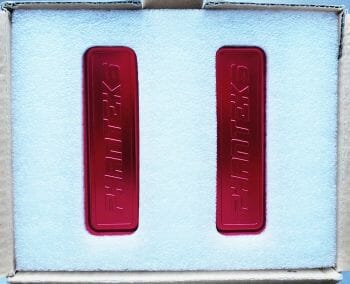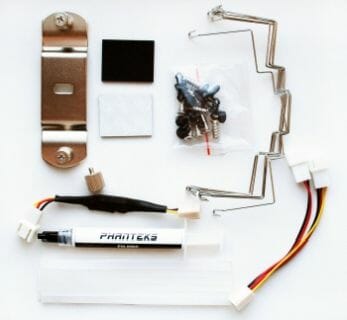Phanteks PH-TC14PE Super-Cooler Review

Let’s check out the design, functionality, performance and noise level of the newest CPU cooler supporting LGA 2011 platform.
Almost a year has passed since Thermalright Archon came out, which we still consider the best air cooler for CPUs. A lot of highly efficient cooler has come out since then, but only one of them, NZXT Havik 140, managed to slightly outperform the leader in cooling efficiency, though yield to it in acoustics.
And finally the Dutch Phanteks Company with 20 years of experience in thermal industry, but no presence in the computer component market, has released PH-TC14PE cooler that combines a number of interesting solutions, some of which we have already come across before.

Moreover, the cooler is available in four different color schemes: silver, blue, red and orange. In other words, the cooler is the same, but there are four of them 🙂 Let’s see what the new Phanteks offspring is capable of and if it will be able to outperform the Thermalright cooler.
Packaging and Accessories
We received two cooler samples for our today’s review: a silver PH-TC14PE and a red PH-TC14PE-RD. Both coolers are shipped in identical boxes made of thick cardboard. Although the boxes are pretty large, they do not have any carry-handles:

But this is a real trifle. As for the informational value of the Phanteks boxes, we can’t complain: the back and side panels of the boxes bear extensive information about the cooler, its features and unique peculiarities:



The packaging is also extremely reliable, because there is additional cardboard casing inside. The small box with accessories is inserted between the heatsink arrays and there is soft polyurethane foam padding on top:

The accessories box contains several different retention kits, installation manual and a few other items:

It is very convenient that each kit is sealed inside a separate plastic bag and marked accordingly, which simplifies the assembly and installation procedure and minimizes the number of times you will consult the manual (although we strongly recommend reading it anyway before installation).
The retention kits for Intel platforms include a backplate with insulating padding, two steel brackets, black plastic bushes, mounts, screw-nuts and additional double-sided mounts for the LGA 2011 systems:


The retention kit for AMD processors contains steel retention brackets, white plastic bushes and four screws. In this case you will be using a default backplate that is why it is not included with the kit.
All components that are identical for both platforms are sealed in an individual plastic bag:

Here you will find a universal retention plate, six silicone strips for the fans, fan retention kit with wire clips, an adapter with a lowering resistor, a Y-splitter, and even Phanteks RH-NDC thermal paste. As for the latter, the only thing we know about it is that it contains diamond nano-particles. However, for some reason Phanteks didn’t mention anything else about this thermal paste, even such a common characteristic as thermal conductivity. I can’t help mentioning that some of the bundled accessories remind us of the Austrian Noctua NH-D14. I assume this is simply a coincidence, but who knows, maybe not quite? Especially, since Phanteks PH-TC14PE heatsink is very similar to that of the NH-D14, as you will very soon see…
The new cooler is manufactured in Taiwan and comes with a 5-year warranty. The recommended price of the silver Phanteks PH-TC14PE is $89.99, while the blue, red and orange models cost $10 more.
Design and Functionality
First let’s take a look at the Phanteks PH-TC14PE heatsink from the red cooler model (although it looks more like pink to me):
This heatsink has two fin arrays, each sitting on five copper heatpipes 8 mm in diameter. Each array consists of 43 aluminum fins 0.45 mm thick with 2.0 mm gaps between them. There is a decorative cover with the company name on top of each heatsink array.
The heatsink is 163 mm tall, and each fin measures 140×50 mm. There is a 30 mm wide gap between the heatsink arrays.
The calculated effective heatsink area is about 12,000 cm2, which is one of the best among processor air-coolers these days. The heatsink itself (without the fans) also weighs quite substantially – 970 g.
The heatsink finds have jagged exterior edges where the airflow enters and exits the heatsink, which allows lowering the airflow resistance and maintain high cooler efficiency at low fan rotation speeds.
Phanteks heatsink boasts two unique technologies. The first one is called P.A.T.S. (Physical Antioxidant Thermal Shield) and it reflects thermal energy generated by other heat sources besides the CPU. I am talking about the graphics card, South and North Bridges of the chipset, memory, voltage regulator components, etc. In other words, Phanteks heatsink with P.A.T.S. technology may remain the coolest components among other heat sources in the system. It is hard to tell how they achieve this, therefore let’s make a smart face and take the marketing promises for granted this time.
The second technology is called C.P.S.C. (Cold Plasma Spraying Coating) and its description seems to be more realistic. The idea behind this technology is to provide more contemporary and efficient contact between the heatsink fins and heatpipes as well as between the heatpipes and the base. The heatpipes not only go through wide 2 mm necks, but these necks do not have the traditional “locks”, which are so typical of the processor heatsinks. Therefore, the contact is ensured over the entire circular surface of the heatpipe.
Once the contact spots between all heatsink parts have been soldered together, they applied a very thin layer of some composite material, which should ensure even more efficient heat transfer between different cooler components (base plate, heatpipes and fins). It is a truly unique solution.
The nickel-plated heatsink plate is 45×42 mm big and its surface is pretty nicely finished. Even though you clearly see the machine marks on it, you can’t feel them to the touch.
8 mm heatpipes are placed right next to one another in the cooler base and the thinnest part of the base plate beneath them is 3 mm.
The base surface has a barely noticeable lengthwise prominence, which together with a n uneven heat-spreader of our test processor produced the following thermal paste imprints.
I have to admit that the result is very decent for both surfaces.Phanteks PH-TC14PE is equipped with two nine-blade PH-F140 fans measuring 140x140x25 mm.
The fans are also unique and boast distinctive peculiarities. First of all I have to mention MVB technology (Maelström Vortex Booster), when each fan blade has three additional fins on the exterior surface. Moreover, these fins are placed differently on each blade.
According to Phanteks engineers, this solution allows creating powerfully controlled airflow. The MVB produces a downdraft vortex allowing air passage through the surface to produce a significantly better performance while keeping the noise level down. We have already seen something similar in Noctua and Zalman fans. The impeller of Phanteks fans is 131 mm in diameter and features a 36 mm rotor.
The second peculiarity of these fans is their unique Updraft Floating Balance (UFB) bearing with an additional balancing ring and phenomenally long (declared) MTBF of 150,000 hours or over 17 years of non-stop operation. Users will no longer remember the unimpressive take-off of AMD “Excavator” and disappointing performance gain from Intel’s new “Ivy Bridge”, and Phanteks PH-F140 fan will keep working and working.
Moreover, the fans support auto-restart and are bundled with a Q.S.A. adapter that allows reducing the rotation speed from the nominal 1200 RPM to 900 RPM. In this case the generated airflow will drop from 78.1 CFM to 60.1 CFM, the static pressure will go down from 1.21 mmH2O to 0.69 mmH2O, and the noise will reduce from 19 dBA to 15.2 dBA. Maximum power consumption of each fan shouldn’t exceed 1.8 W at 0.15 A current, which is exactly what the rotor sticker says.
According to our measurements, two PH-F140 fans consume no more than 2.6 W, so here the specifications are right to the point. The fans do not support PWM control and come with 400 mm long cables.
Each Phanteks PH-F140 fan is attached to the heatsink using two wire clips, which should first be inserted into the loops of the plastic mounts inserted into the fan retention holes.
It is not very convenient to insert the clips into these loops, but they will definitely guarantee that the fans don’t move anywhere during their 17-year life span. There are six wire clips included with the cooler, which will be enough to install not only two included fans, but also the third additional fan, if necessary.
You should stick shock-absorbing silicone strips to the edge of each heatsink array.They will reduce the vibrations transfer from the fan and this way lower the level of noise.
Compatibility and Installation
Phanteks PH-TC14PE is compatible with all contemporary processors including the just launched LGA 2011 platform. Even though currently the official list of compatible mainboards doesn’t include any LGA 2011 products, all other platforms are well represented. The installation procedure is described in detail in the step-by-step installation guide. We, however, will discuss it using our LGA 1366 testbed as an example.
You should use the same universal backplate with insulating padding for all Intel platforms with LGA 775/1155/1156/1366 sockets. There are special threaded mounts to be inserted into the holes in its ends.
After that the backplate is installed on the back side of the mainboard PCB.The mounts pierce the mainboard through plastic bushes and steel panels and are secured in place with large screw-nuts.
The last thing to do is to apply a layer of thermal paste on the processor heat-spreader, install the heatsink on top and evenly tighten the screws through the steel panels. The retention provides superb pressure, the heatsink is dead locked in place, and the screw holding the bracket in place together with a special notch in the base prevent the cooler from shifting or rotating.
Once the cooler has been installed, the distance between the mainboard PCB and the lowest Phanteks PH-TC14PE heatsink fin is 45 mm, which will be enough to avoid conflicts with tall memory heat-spreaders as well as with heatsinks on the processor voltage regulator components around the CPU socket.
However, if you install the 140 mm fans exactly in the center of the heatsink, they will be hanging almost 15 mm below the last heatsink fin. And this is when we will obviously have to deal with some memory modules compatibility issues.
However, if you have memory modules with tall heat-spreaders, you can do just fine with one fan in the center of the heatsink, or place an additional fan onto the external side of the second heatsink array.
The enormous Phanteks PH-TC14PE looks very impressive inside the system case.By the way, this cooler with the fans attached weighs 1250 g and is 171 mm tall.
Phanteks PH-TC14PE turned out very dependent on the way it is installed on top of the processor: when we rotated the cooler by 90 degrees from what you see on the photo above, the temperature of each CPU core increased by 6-7°C. However, it appeared to be caused not by some unique peculiarity of this particular cooler, but by completely unacceptable contact between the CPU heat-spreader and the cooler base in this position.
With the exception of the price, everything else is exactly the same as by the red model, and it will also be the same for the blue and orange coolers. Unfortunately, the unevenness of the base was also present in the second cooler, which indicates that it may be a more of a permanent issue, just like by Thermalright’s products.
Testbed and Testing Methodology
We performed all cooler tests inside a closed system case. Here is our testbed configuration:
- Mainboard: Gigabyte GA-X58A-OC (Intel X58 Express, LGA 1366, BIOS F5c from 09/06/2011);
- Processor: Intel Core i7-980X Extreme Edition, 3.33 GHz, 1.225 V, 6 x 256 KB L2, 12 MB L3 (Gulftown, B1);
- Thermal interface: ARCTIC MX-4;
- Graphics card: Asus Radeon HD 6770 DirectCU Silent (EAH6770 DCSL/2DI/1GD5) GDDR5 128 bit, 850/4000 MHz (with a passive heatsink from the DeepCool V4000 VGA cooler);
- Memory: DDR3 3 x 2 GB OCZ Platinum Low-Voltage Triple Channel (Spec: 1600MHz / 7-7-7-24 / 1.65 V);
- System drive: RAID-0 of 2 x Kingston V-series SNV425S2128GB SSD (SATA-II, 128 GB, MLC, Toshiba TC58NCF618G3T controller);
- Drive for programs and games: Western Digital VelociRaptor (300GB, SATA-II, 10000 RPM, 16MB cache, NCQ) inside Scythe Quiet Drive 3.5” HDD silencer and cooler;
- Backup drive: Samsung Ecogreen F4 HD204UI (SATA-II, 2 TB, 5400 RPM, 32 MB, NCQ);
- System case: Antec Twelve Hundred (front panel: three Noiseblocker NB-Multiframe S-Series MF12-S2 fans at 1020 RPM; back panel: two Noiseblocker NB-BlackSilent PRO PL-1 fans at 1020 RPM; top panel: standard 200 mm fan at 400 RPM);
- Control and monitoring panel: Zalman ZM-MFC2;
- Power supply: Xigmatek “No Rules Power” NRP-HC1501 1500 W (with a default 140 mm fan).
We overclocked our six-core processor (with its default non-lapped heat-spreader) with the multiplier set at 25x and “Load-Line Calibration” (Level 2) enabled to 4.3 GHz. The nominal processor Vcore was increased to 1.3875 V in the mainboard BIOS.
Turbo Boost and Hyper-Threading technologies were disabled during our test session. The memory voltage was at 1.5 V and its frequency was 1.38 GHz with 7-7-7-16_1T timings (Extreme profile). All other parameters available in the mainboard BIOS and related to CPU or memory overclocking remained unchanged.
All tests were performed under Windows 7 Ultimate x64 SP1 operating system. We used the following software during our test session:
- CPU Stress Test (CST) version 0.18b – to load the processor (matrix # 15, 10-12 minutes);
- Real Temp GT 3.64 – to monitor the processor core temperature;
- CPU-Tweaker 1.5 – to visually monitor temperatures and frequencies using graphics;
- Gigabyte Easy Tune 6 B11.0823.1 – to monitor voltages.
The CPU was loaded with two consecutive CST test runs with the settings as indicated above. The stabilization period for the CPU temperature between the two test cycles was about 8-10 minutes. We took the maximum temperature of the hottest CPU core for the results charts. Moreover, we will also provide a table with the temperature readings for all cores including their average values. The ambient temperature was checked next to the system case with an electronic thermometer with 0.1 °C precision that allows hourly monitoring of the temperature changes over the past 6 hours. The room temperature during our test session varied between 23.2-23.6°C.
The noise level of each cooler was measured between 1:00 and 3:00 AM in a closed room about 20 m2 big using CENTER-321 electronic noise meter. The noise level for each cooler was tested outside the system case when the only noise sources in the lab were the cooler and its fan. The noise meter was installed on a tripod and was always at a 150 mm distance from the cooler fan rotor. The tested cooling systems were placed at the edge of the desk on a sheet of polyurethane foam. The lowest noise reading our noise meter device can register is 29.8 dBA and the subjectively comfortable noise level in these testing conditions was around 36 dBA (do not mix it up with low noise level). The fan(s) rotation speed was adjusted in the entire supported range using our in-house controller by changing the voltage with 0.5 V increment.
We are going to compare Phanteks PH-TC14PE against Thermalright Archon ($74.95).
It was tested with one as well as two Thermalright TY-140 fans. Phanteks PH-TC14PE was also tested with the same fans besides the default PH-F140 fans, of course.
Now let’s check out the obtained results.
Cooling Efficiency Tests
First of all I have to say that there is no difference in cooling efficiency between Phanteks coolers of different colors (red and silver). Speaking of the individual processor cores the temperature was 1°C lower under the silver model. However, these deviations are most likely connected with the more/less successful installation of the cooler on the processor heat-spreader.
When we compared the two coolers tested with their default fans (two fans by Phanteks PH-TC14PE and one fan by Thermalright Archon), the Phanteks newcomer won a convincing victory. At 600 RPM PH-TC14PE was 7°C more efficient, at 800 and 1000 RPM – 5°C more efficient, and at speeds beyond 1200 RPM – Archon is only 2°C behind. At the same time, the performance of the new Phanteks PH-TC14PE with only one default fan installed between the two heatsink arrays show that this cooler can compete against Archon with one cooling fan. Only at maximum fan speed, which is higher by TY-140 (1260 RPM compared with 1210 RPM of the Phanteks fan), Thermalright cooler is 3°C more efficient. However, in my opinion, no one will really purchase expensive Phanteks PH-TC14PE with intention to remove one of its fans. There are cheaper and more compact models available in this case.
As for the performance of PH-TC14PE and Archon coolers tested with two identical Thermalright TY-140 fans, the Phanteks newcomer again doesn’t give in to its powerful competitor. On the contrary, Thermalright TY-140 fans fit the PH-TC14PE heatsink even better than the original ones, because at the same rotation speeds the “upgraded” Phanteks PH-TC14PE is up to 2°C more efficient than the original configuration. As a result, the new Phanteks cooler is 2-3°C more efficient than Thermalright Archon when both are tested in identical conditions at the same speeds of the same exact fans. This is substantial difference for a super-cooler. I would also like to add than by adding the third fan to the PH-TC14PE heatsink we can only improve its cooling efficiency at 600 RPM speed by about 2°C. We didn’t detect any changes at higher speeds compared with the two-fan configuration.
The maximum overclocking tests of our six-core processor under Phanteks PH-TC14PE proved that it is a superior product that is capable of cooling our Gulftown CPU with over 250 W calculated TDP, which was successfully overclocked to 4.5 GHz frequency at 1.46875 V Vcore.
Here I would like to point out once again that alternative Thermalright fans do a better job with Phanteks heatsink than the original PH-F140 ones, because with alternative fans the peak temperatures end up being 2-3°C lower.
Phanteks PH-TC14PE has obviously taken the leading positions in our performance ranks although it was as efficient as Thermalright Archon with two TY-140 fans (as you know the default Archon configuration includes only one fan like that).
The next diagram and table sum up the maximum CPU overclocking results for each tested cooler. Besides the CPU frequency, they also show maximum CPU temperature (taking into account the room temperature delta) and the generated noise.
The results are again simply excellent. Only compact liquid-cooling systems did a little bit better here in terms of temperatures, but they obviously lost to the new Phanteks PH-TC14PE in terms of noise. Nevertheless, I have to point out that NZXT Havik 140 and Thermalright Archon are capable of the same maximum CPU overclocking. Moreover, their noise level will be somewhat lower in this case, and this is what we are going to discuss next.
Acoustic Performance
We measured the noise from our testing participants in the entire supported speed range of their fans following the methodology described above. The results are summed up on the following graph.
Unfortunately, Phanteks PH-TC14PE can’t boast quiet operation even with one PH-F140 fan, not to mention the default two-fan configuration. The difference from the Thermalright TY-140 is pretty serious, so we can’t call the new cooler quiet per say. It remains acoustically comfortable up to 830 RPM with one PH-F140 fan and up to 700 RPM with two such fans, so it could really use PWM control feature.
Conclusion
Phanteks PH-TC14PE is a typical super-cooler with all features typical of a product of this class. It is very large in size, heavy, completely universal and expensive, but at the same time remarkably efficient and moderately noisy. If we do not take into account the last characteristic, PH-TC14PE will be undoubtedly the today’s most efficient processor cooler (with the exception of the LGA 2011 platform, which we haven’t yet tested in our cooling lab).
At the same time, we have to admit that the fans are relatively noisy and lack PWM control. Also, the price of the new Phanteks PH-TC14PE is fairly high, which makes this cooler appealing only to a limited number of wealthy computer enthusiasts. I am confident that a lot of users on a budget would be interested in a fanless Phanteks PH-TC14PE modification (the fans are priced at $24.99 a piece, by the way), which could allow lowering the cooler price substantially and using other more affordable fan models with it.
However, if you consider yourself an uncompromising extreme overclocker favoring air-cooling products and you are not discouraged by not very quiet fans and high price, then Phanteks PH-TC14PE will undoubtedly be the best choice and will ensure your CPU stays cool at all times. Therefore, we are proud to award Phanteks PH-TC14PE our Ultimate Innovation title.
Without a doubt, Phanteks had a really successful start. I sincerely hope that they will continue doing a great job and will soon offer us other interesting cooling products.